1991
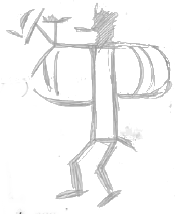
DIDA’LATLI’‘TÏ (To Destroy Life)
Sgë! Nâ’gwa tsûdantâ’gï tegû’nyatawâ’ilateli’ga. Iyustï (O O) tsilastû’‘lï lyu’stï (O O) ditsadâ’ita. Tsûwatsi’la elawi’nï tsidâ’hïstani’ga. Tsû dantâgï elawi’nï tsidâ hïstani’ga. Nû’nya gû’nnage gûnyu’tlûntani’ga. Ä‘nûwa’gï gû’nnage’ gûnyû’tlûntani’ga. Sûn’talu’ga gû’nnage degû’nyanu’galû’ntani’ga, tsû’nanugâ’istï nige’sûnna. Usûhi’yï nûnnnâ’hï wite’tsatanû’nûnsï gûne’sâ gû’nnage asahalagï’. Tsûtû’neli’ga. Elawâ’tï asa’halagï’a’dûnni’ga. Usïnuli’yu Usûhi’yï gûltsâ’të digû’nnagesta’yï, elawâ’tï gû’nnage tidâ’hïstï wa’yanu’galûntsi’ga. Gûne’sa gû’nage sûntalu’ga gû’nnage gayu’tlûntani’ga. Tsûdantâ’gï ûska’lûntsi’ga. Sa’ka’nï adûnni’ga. Usû’hita atanis’se’tï, ayâ’lâtsi’sestï tsûdantâ’gï, tsû’nanugâ’istï nige’sûnna. Sgë!
Mooney, Sacred Formulas of the Cherokee:
When the shaman wishes to destroy the life of another, either for his own purposes or for hire, he conceals himself near the trail along which the victim is likely to pass. When the doomed man appears the shaman waits until he has gone by and then follows him secretely until he chances to spit upon the ground. On coming up to the spot the shaman collects upon the end of a stick a little of the dust thus moistened with the victim’s spittle. The possession of the man’s spittle gives him power over the life of the man himself. Many ailments are said by the doctors to be due to the fact that some enemy has by this means “changed the spittle” of the patient and caused it to breed animals or sprout corn in the sick man’s body. In the love charms also the lover always figuratively “takes the spittle” of the girl in order to fix her affections upon himself. The same idea in regard to spittle is found in European folk medicine.
The shaman then puts the clay thus moistened into a tube consisting of a joint in the Kanesâ’la or wild parsnip, a poisonous plant of considerable importance in life-conjuring ceremonies. He also puts into the tube seven earthworms beaten into a paste, and several splinters from a tree which has been struck by lightning. The idea in regard to the worms is not quite clear, but it may be that they are expected to devour the soul of the victim, as earthworms are supposed to feed upon dead bodies, or perhaps it is thought that from their burrowing habits they may serve to hollow out a grave for the soul under the earth, the quarter to which the shaman consigns it. In other similar ceremonies the dirt-dauber asp or the stinging ant is buried in the same manner in order that it may kill the soul, as these are said to kill other more powerful insects by their poisonous sting or bite. The wood of a tree struck by lightning is also a potent spell for both good and evil and is used in many formulas of various kinds.
Having prepared the tube, the shaman goes into the forest, to a tree which has been struck by lightning. At its base he digs a hole, in the bottom of which he puts a large yellow stone slab. He then puts in the tube, together with seven yellow pebbles, fills in the earth, and finally builds a fire over the spot to destroy all traces of his work. The yellow stones are probably chosen as the next best substitute for black stones, which are not always easy to find. The formula mentions “black rock,” black being the emblem of death, while yellow typifies trouble. The shaman and his employer fast until after the ceremony.
If the ceremony has been properly carried out, the victim becomes blue, that is, he feels the effects in himself at once, and, unless he employs the countercharms of some more powerful shaman, his soul begins to shrivel up and dwindle, and within seven days he is dead.
January 3:
Something new yesterday. I took out a nest of succubi —at least that’s what everyone I talked to says they were. Sexually predatory, voracious demons. They can change their appearance, and they all transformed to look like Mary at one point. God help me, I was weak. It was like seeing her again, in the flesh, and I let myself believe for just a minute. Or not believe, really. I agreed to their deception. And then, when I’d gotten my head straight again, I killed them. All of them. Was going to stay here for a while, but I think we’ll need to be on our way. I’m going to stay in the West. Maybe New Mexico next, so we would be close to Daniel. I’m learning a lot from him, even though I’ve still never seen a vampire.
Succubi exist across world mythologies. Judeo-Christian versions have them as female demons who harvest semen that incubi (male version) then use to impregnate women with children who are more readily possessed by demons —or who are more likely to become witches. Birth defects were also said to be the result of incubi. A parallel European tradition, of the night-mare, is a creature which rides the sleeper, partially suffocating him and at the same time causal sexual dreams. The four succubi named in the Zohar are Naamah, Lilith, Elsheth Zenunium, ang Agrat Bat Mahlat. Naamah was regarded as the inventor of divination, and in some traditions as a patron spirit of music.
In certain strains of Hebrew myth, incubi and succubi are generally called lilin and lilith. They are said to be the children of Lilith, and to die at a rate of one hundred per day because she would not come back to Adam. They can prey on children —boys until circumcision at eight days, and girls for twenty days— but also attack women by causing infertility and difficult births, even miscarriages. Men become victims of the lilith by being ridden at night, the seed being used to create more demonic children.
An amulet inscribed with the initials of the three Magi —Caspar, Melchior, and Balthasar— is said to protect children from lilin and lilith.
Other traditions include Greek empusa, which attacked travelers but also drained their life force through intercourse, and Turkish Al Basti (which also kidnaps horses). Martin Luther referred to Melusine as a succubus, but she doesn’t seem to fit the mold; Melusine is more of a swan-maiden/selkie/kitsune type.
The succubi I killed said something about having plans for the Winchesters. Guess they’ll have to cancel those plans.
January 24:
Dean turn twelve today. School has started again, but we’re going to move on. Next week, the Winchesters are going to be residents of Albuquerque. Dean’s going to be a normal sixth grader for at least the next couple of months. He even talked about wanting to play baseball this spring, but I’m not sure he’s serious. I think he’s taking his cues from me, talking about everyday stuff when I try to keep us in one place. Then when we’re on the road again, all he can talk about is hunting.
March 17:
In the last week, Sammy has played a sunbeam in the school play and I killed a demon inhabiting the body of an old woman. It knew something the succubi, I think. We’re being followed. Or are we? Am I getting paranoid? I have every reason to be, but it’s something I have to guard against. The boys are doing well. Sammy’s talking about doing a science project to enter in the fair next month. He’s really taken to his teacher, Ms. Lyle, and she’s encouraging him. Smart kid, Sammy. It was warm today, and the boys kicked a soccer ball around. That’s one of the nice things about Albuquerque. I picked up a job working construction. Feels good to be punching a clock again, actually. The regular rhythm of it. Part of me needs that. I thought about going back to turning wrenches, but it didn’t feel right. I think a lot of things died in Lawrence, and that dream was one of them.
April 1:
Monday, I walked away from another job, and my younger son almost was kidnapped by some kind of demon. Sammy qualified for the New Mexico Science Fair, and his teacher, Ms. Lyle, said she’d take him. Only she started to take him somewhere else. I don’t know where, but I caught up to her at a crossroads. She would have killed me, and taken Sammy, but Dean came through. I don’t have any words for how proud I am of him. His brother’s under some kind of spell, there’s a giant monster made out of train parts coming after me, and he has the presence of mind to find this journal and read the exorcism out of it. I almost lost both of my boys today. Ms. Lyle, or the thing calling itself Ms. Lyle, wanted Sammy for something. It reminds me of the variant stories about succubi/lamiae taking children children, or killing children. And if I’m honest with myself, I have to take that train of thought all the way: the stories also say that succubi come to claim the children that have been fathered by incubi, which is ridiculous.
I still don’t know what Ms. Lyle wanted. She just said Sam was special.
We’re on the road again. How am I going to explain to Sammy that we’re not going back to school? How am I going to explain Ms. Lyle?
To top it all off, I had to give Sammy a sharp lecture on not talking to strangers. While I was on the phone with Bobby, he just got out of the car and went up to a black Seville. I read him the riot act —Dean too, since he let it happen and it’s his job to watch Sammy. All Sammy would say about it was that the guy wanted to know where we were going.
April 7:
In Sioux Falls to meet Bobby, boys along since it’s not safe for them to be in Albuquerque anymore. Between the two of us, Bobby and I hashed out what’s been going on with Ms. Lyle and the others. Bobby thinks I’m a fool for not wanting to believe that demons really exist, and he’s not shy about telling me. Probably he’s right. All the signs were there with Ms. Lyle. But if you buy demons, you have to buy Hell, and if you buy Hell, you have to buy Satan, which means you have to buy God, right? I can’t sign on to one belief if it means I have to take the others. Only Bobby says that he’s never run across a demon who’s laid eyes on the Devil. Most demons apparently don’t even believe he exists. The way Bobby put it is that demons are a lot like us where belief is concerned. I don’t see it that way. If demons exist, they are nothing like us.
But I guess I think they do exist. And I think Ms. Lyle was one. I was in bed with her… that thing… and it was a demon. I let it trick me away from the mission. I let myself be led, I let myself be convinced that everything can be normal again, and it was all a tactic. She wanted something from me, and she thought she knew how to get it.
And she was almost right. I’ve been lonely since Mary… I wanted to be touched. Just contact. And looking back, it makes me sick.
Have been reading up on crossroads out of Bobby’s library. There’s a nearly universal folk-magic tradition that crossroads are gateways between worlds. Robert Johnson: “I went to the crossroads/trying to flag a ride.” And then he writes “Hellhound on My Trail,” too. Wonder if he knew something… plenty of stories that he sold his soul to the Devil, but people have been saying that about musicians since medieval times. Another medieval note: criminals and suicides used to be buried at crossroads. A sacrifice to the spirits that used those gateways?
Papa Legba in voodoo magic is the loa of crossroads. You go to him if you want to talk to the iwa, the gods (going back to Yoruba traditions). He is the gatekeeper, also perhaps a psychopomp —like Eshu (sometimes called Ellegua in the Yoruba/Lukumi, later Exu in Brazilian folk magic). Eshu is the patron of travelers, god of crossroads. He’s also a trickster, sometimes a cruel one. Both Eshu and Papa Legba must be the first of any spirits invoked if a magical or divination ritual is going to work. His symbol, called a veve:
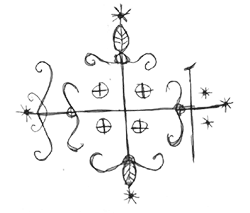
Veve is inscribed on the floor in some kind of powder. It can be anything from flour to gunpowder, depending on the ceremony. Hoodoo traditions prescribe certain actions at crossroads to gain gifts in music, love, or power. Or money.
April 18:
Went to see Silas last night. He’s an old friend of Bobby’s, some kind of soothsayer who sells tires. I went to his place and his daughter told me he’s been in a coma… since last November 2, the seventh anniversary of Mary’s death. When I went to see him at the hospital, he snapped out of it long enough to tell me a couple of things I didn’t want to hear.
One, he thinks that Sammy’s special somehow.
Two, Dean and I need to be ready “for what’s to come.”
Then he was gone again, out cold. What the hell does it mean? Why Sammy? What does he have to do with any of this? And what is coming? Silas either couldn’t say anything else, or wouldn’t. He said I brought him out of his coma, and then he was gone back into it.
Tomorrow I’m going to leave Sammy with Bobby so I can take Dean deer hunting. It’s out of season, but the Dakotas are lousy with deer and Dean needs to pull a trigger to sharpen him up. Also I need to think about Sammy. Why was Ms. Lyle so interested in him?
More voodoo. The houngan (man) or mambo (woman) is the priest. You need them to talk to the loas, also called orisha (loas also known as iwa —African and New World terminologies mix freely). Orisha are said to be beings who manifest aspects of the natural world, and aspects of a nameless god. So they straddle the physical and spirit worlds. The bokor is a magician-priest who can do both divination/séance magic and darker magic: hexes, charms, etc. They’re usually for hire. Bobby says that it’s possible to be both houngan and bokor. Bokor are the ones who make zombies.
Ogun is the loa (or maybe iwa, or orisha?) of iron, smithy, hunting, fire, etc. He’s a warrior. His veve:
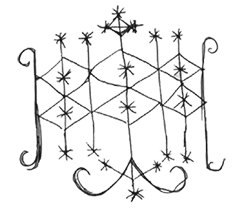
I’ve been hearing about a magical gun. The story goes that Samuel Colt one Halloween night made a gun and thirteen bullets that could kill anything. Wonder if that gun exists, or if it’s just a hunter legend. And if it exists, I wonder where it is… Ogun would know. Tomorrow, after Dean and I go hunting, might be the time to ask him. Go to New Orleans? Must be a bokor down there who would do a hunter a favor.
Other veves:
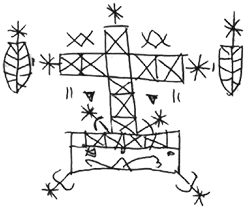
Baron Samedi, loa of the dead, stands at crossroads. Also loa of sex, known for his coarse apetites. Eros and Thanatos, all in one, dressed in tux and top hat. If you want to talk to him, bring plenty of booze and tobacco.
Maman Brigitte, Baron Samedi’s wife, vulgar like her husband, likes to drink hot peppers. Protects gravestones if they are sanctified to her. She and Baron Samedi are related to the Ghede, a family of spirits that have to do with cemeteries, funerals, death, etc. Different traditions spell out the relationship differently. Either Samedi is a Ghede, or he created them or brought them to life, or he is an aspect of them and they speak through him.
I have to sleep. Up early tomorrow.
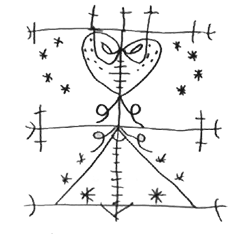
April 19:
The hunting trip was nearly a disaster. Dean missed his shot. I sent him after the buck, a beautiful twelve-pointer, and he dropped the gun when he tripped on the trail. Then out of nowhere comes Sammy, who picks up the gun and lays that big boy out. A seven-year-old… well, almost eight.
Then he tells me that he thought the deer had taken Dean’s gun, and that Sammy had to protect him.
It’s moments like those that kill me. I taught him that, Dean too. I taught them that everything should be seen as a threat. And now Sammy sees a deer and thinks it’s trying to hurt his brother.
God.
Things got worse from there because Sammy told me he’d gotten up, wanting to come after me and Dean, and found the man in the black Seville outside Bobby’s house. He rode in the Seville to the trailhead, and found us from there. I don’t even know how to get my head around that. I feel like I should punish him somehow, but the truth is I should be punishing myself.
We get home, and Bobby tells me to go see Silas again. I didn’t want to do it, but when I got to his house, there he was, awake and standing in his front door like he’d never been sick in his life. I don’t know how to explain it. He said again that Sammy was special, and he wanted some time to talk to Sam and understand what was happening. So Dean and I left for an hour, and on the way back I saw the Seville.
When we got to Silas’ place, there was Sammy, sitting on the porch. He said he and Silas talked for a while. I went inside, left Dean out with his brother to catch up. Inside… I’ve never seen anything like it. Or if I have, it was after an artillery strike in Nam. Silas was just in pieces, little bits of him stuck to the walls and the floor. Scrawled in blood on the kitchen cabinets, the words KILL HIM.
Now I’ve got to find the sonofabitch that killed Silas, too.
April 20:
Been on the run, running harder even than usual. The driver of the Seville called himself Anderson, said he was a hunter… and he was hunting Sam. He said Sam had killed Silas, but there’s no way that can be true. No little boy could have done what I saw in there. But Anderson wouldn’t listen, and now in the last twenty-four hours I’ve committed kidnapping, grand theft auto (well, semi), and murder. That’s five hunters I’ve killed, if you count H —but who really knows what he was? And I don’t know that Anderson was what he said he was, either. He passed up two chances to take Sammy out. I didn’t give him a third. And I didn’t give any of three Dowry brothers a chance at all.
It was Dean who dilled Anderson. My oldest son is blooded. All I ever write about is death. Because all I ever see is death, and you know what? I did that to myself. It’s got to end, but it can’t end until I settle what happened to Mary.
May 2:
Sammy is eight years old today. Happy birthday, kiddo. No matter what the demons and soothsayers and lunatic albinos say, you’re special to me just because you’re my son. And I’m never going to let anything happen to you.
Ms. Lyle was after Sammy because he has something she wants. She said he was special. So did Silas. What’s different about him? He’s just a boy. My boy.
Have started reading about demonology because of Bobby. I still have a hard time believing it. So far I’m sorting through a couple of different books that he says are important.
A New and Complete Illustration
of the Occult Sciences (OS)
Written by Ebenezer Sibly. Fourth volume in a series begun 1784 and mostly dedicated to astrology. A disciple of Swedenborg and Mesmer. Makes liberal use of Reginald Scot’s Discoverie of witchcraft and Agrippa’s De Occulta Philosophia.
Pseudomonarchia Daemonum (PD)
Written by Johann Weyer, 1563, from a book he calls Liber officiorum spiritum, seu Liber dictus Empto. Salomonis, de principibus & regibus aemoniorum (note reference to Solomon here and in Weyes’s subtitle: “Salomon’s Notes of Conjuration”). Weyer a student of Agrippa The Pseudomonarchia has much in common with the first book of the Lemegeton, called Goetia. A lengthy catalog of demons, with variations on their names, notes on their appearances, and brief instructions on conjurations and abjuration. Translated into English prior to 1584 by Reginald Scot as part of his Discoverie of Witchcraft. Full of odd notes about how many legions each demon controls, etc. Most of this isn’t useful, but the characteristics of individual demons shed some light on the quest.
Goetia has better diagrams, and is useful for actual conjuration.
The Testament of Solomon (TS)

Probably written 1st-4th century C.E. In Solomon’s voice, tells of the building of the Temple and of the binding of numerous demons to perform menial labor. Several of these demons not attested in other sources. The story goes on to tell how Solomon fell in love with a Jebusaean woman (Shunammite?) and desired her for a wife, but was told by the priests of Moloch that he could not have her unless he sacrificed five grasshoppers to Moloch. In a moment of weakness, he did, and fell away from God, becoming “the sports of idols and demons.”
One of dozens of texts that characterize Solomon as an archmagician. Queen of Sheba characterized as a witch, unlike her presentation in the OT. Also interesting that the Koran refers to the tradition that Solomon built the Temple with the assistance of bound demons: see sura 21, 34, 38.
PD. In its entry on Gaap, says that Solomon wrote a book of conjurations, and “mingled therewithalall the holy names of God.”
May 17:
This would have been our thirteenth anniversary. Lace. Eleven is steel, twelve and thirteen are silk and lace? Feels like it should be the other way around, that steel should come later. Or maybe once you’ve got the steel to keep a marriage going, then you get to enjoy the silk and lace.
I’ll never know.
November 2:
Mary has been dead for eight years. I’ve been
learning about reapers. There’s more than one, and it’s not always
a hooded skeleton with a scythe, but that’s where I’ll
start.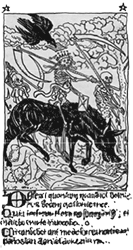 The
traditional Grim Reaper is a skeleton or solemn-looking man
carrying a scythe, who cuts off people’s lives as though he were
harvesting grain. Death personified is a figure or fictional
character which has existed in mythology and popular culture since
the earliest days of storytelling. Because the reality of death has
had a substantial influence on the human psyche and the development
of civilization as a whole, the personification of Death as a
living, sentient entity is a concept that has existed in all known
societies since the beginnings of recorded history. In the United
States, Death is usually shown as a skeletal figure wearing a
midnight-black gown with a hood, while in Europe he is often
depicted similarly but dressed in white, which is the traditional
color worn at funerals in many places.
The
traditional Grim Reaper is a skeleton or solemn-looking man
carrying a scythe, who cuts off people’s lives as though he were
harvesting grain. Death personified is a figure or fictional
character which has existed in mythology and popular culture since
the earliest days of storytelling. Because the reality of death has
had a substantial influence on the human psyche and the development
of civilization as a whole, the personification of Death as a
living, sentient entity is a concept that has existed in all known
societies since the beginnings of recorded history. In the United
States, Death is usually shown as a skeletal figure wearing a
midnight-black gown with a hood, while in Europe he is often
depicted similarly but dressed in white, which is the traditional
color worn at funerals in many places.
Examples of death personified are:
- In modern-day European-based folklore, Death is known as the Grim Reaper or the Grim Spectre of Death.
- In Islam, Death is portrayed as Azrael, the angel of death (note that the name “Azrael” does not appear in any versions of either the Bible or the Koran).
- Father Time is sometimes said to be Death.
- Psychopomp is a spirit, deity, or other being whose task is to conduct the souls of the recently dead into the afterlife.
In Ugaritic Mot “Death” (spelled mt) is personified as a god of death. The word is cognate with forms meaning “death” in other Semitic languages: with Hebrew (“moth” or “maveth”); with Caraanite, Egyptian Aramaic, Nabatean, and Palmyrene (“mut”); with Jewish Aramaic, Christian Palestinian Aramaic, and Samaritan (“mut”); with Syriac “maat”?; With Mandaean “muta”; with Akkadian “m’tu”; with Arabic “maut”; with Ge’ez “mot”. Although Semitic languages aren’t closely related to Indo-European languages, the words for “death” in Sanskrit (“mrit”) and Latin (“mortus”) are similar.
Mot (Death), son of ’El, according to instructions given by the god Hadad (Ba’al) to his messengers, lives in hmry (Mirey), a pit is his throne, and Filth is the land of his heritage. But Ba’al warns them:
that you not come near to divine Death,
lest me made you like a lamb in his mouth,
(and) you both be carried away like a kid in the
breach of his windpipe.
Hadad seems to be urging that Mot come to his feast and submit himself to Hadad.
Death sends back a message that his appetite is that of lions in the wilderness, like the longing of dolphins in the sea, and he threatens to devour Ba’al himself. In a subsequent passage Death seemingly makes good his threat, or at least is deceived into believing he has slain Ba’al. Numerous gaps in the text makes this portion of the tale obscure. Then Ba’al/Hadad’s sister, the warrior goddess ’Anat, comes upon Mot, seizes him, splits him with a blade, winnows him in sieve, burns him in a fire, grinds him between millstones, and throws what remains on the field for the birds to devour.
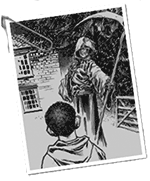
But after seven years Death returns, seeking vengeance for the splitting, burning, grinding, and winnowing, and demanding one of Ba’al’s brothers to feed upon. A gap in the text is followed by Mot complaining that Ba’al has given Mot his own brothers to eat, the sons of his mother to consume. A single combat between the two breaks out until Shapsh (Sun) upgraids Mot, informing him that his own father ’El will turn against him and overturn his throne if he continues. Mot concedes and the conflict ends. In Sanchuniathon also Death is son of ’El and counted as a god, as the text says in speaking of ’El/Cronus:
… and not long afterward he consecrated after his death another of his sons, called Muth, whom he had by Rhea; this (Muth) the Phoenicians esteem the same as Thanatos [“Death”] and Pluto.
But earlier in a philosophical creation myth Sanchuniathon has referred to great wind which merged with its parents and that connection was called Eros (Desire):

From its connection Mot was produced, which some say is mud, and others a putrescence of water compound; and out of this came every germ of creation, and the generation of the universe. So there were certain animals which had no sensation, and out of them grew intelligent animals which were called “Zophasemin,” that is “observers of heaven”; and they were formed like the shape of an egg. Also Mot bust forth into light, and sun, and moon, and stars, and the great constellations.
The language here is confusing, a bad summary and possibly corrupt, and the form “Mot” here is not the same as “Muth,” which appears later. But it may be that the full and coherent account would have made clear that muddy and putrescent Death is the source of life.
Putting God on Trial - The Biblical Book of Job: A Biblical Reworking of the Combat Motif Between Mot and Ba’al.
December 25:
Sometimes I think Sammy’s been reading this journal.
But he’s not going to read it tonight, because here we are, Christmas night, and there’s two hundred miles of scrub prairie and desert between me and them. No Christmas tree, no carrots and milk for Santa and the reindeer. A couple of days ago I handed them presents, and they gave me a set of night-vision goggles that Dean must have pinched from a gun show we passed through in Amarillo a couple of months ago. They’re growing up without me. And they’re both starting to act out a little, because we’re apart so much. Sam gets resentful and has some trouble handling his temper. Dean tries to fix everything and keep us together as a team. Neither of them should have to do those things.
After this year… the succubi and Ms. Lyle (Lilith?), Silas… this has been a rough one. They came after my boys. We made it, but they’re going to keep coming. This enemy doesn’t quit until they’re dead, and I don’t even know who’s sending them. How do I fight them?
And how do I avoid this question: Would the boys be better off somewhere else, with someone else, living normal lives?
No. I’m their father. They belong with me.
Merry Christmas, everyone.